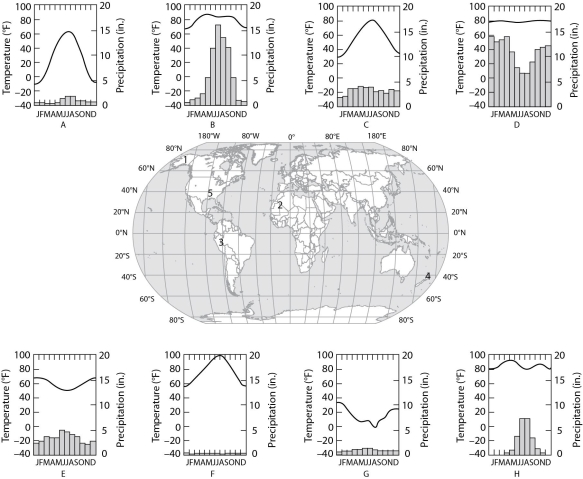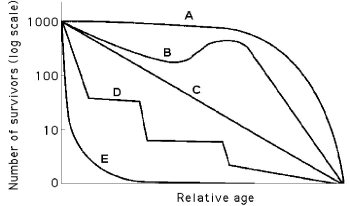A) savanna
B) temperate broadleaf forest
C) temperate grassland
D) tropical rain forest
E) northern coniferous forest
Correct Answer

verified
Correct Answer
verified
Multiple Choice
Which of the following is the best natural example of uniform distribution?
A) bees collecting pollen in a wildflower meadow
B) snails in an intertidal zone at low tide
C) territorial songbirds in a mature forest during mating season
D) mushrooms growing on the floor of an old-growth forest
E) a cultivated cornfield in the Midwest
Correct Answer

verified
Correct Answer
verified
Multiple Choice
Use this description to answer the following question. In areas of permafrost, stands of black spruce are frequently observed in the landscape, whereas other tree species are noticeably absent. Often these stands are referred to as "drunken forests" because many of the black spruce are displaced from their normal vertical alignment. -What might be the adaptive significance of these unusual forests growing the way they do in this marginal habitat?
A) Needles are adapted to withstand cold arctic temperatures.
B) Branches are adapted to absorb more CO2 with this displaced alignment.
C) Taproot formation is impossible, so trees developed shallow root beds and easily tilt.
D) Trees are tilted so that snow won't break them or tip them over.
E) Trees tip so that they do not compete with each other for sunlight.
Correct Answer

verified
Correct Answer
verified
Multiple Choice
A population's carrying capacity
A) may change as environmental conditions change.
B) can be accurately calculated using the logistic growth model.
C) generally remains constant over time.
D) increases as the per capita growth rate (r) decreases.
E) can never be exceeded.
Correct Answer

verified
Correct Answer
verified
Multiple Choice
Carrying capacity is
A) seldom reached by marine producers and consumers because of the vast resources of the ocean.
B) the maximum population size that a particular environment can support.
C) fixed for most species over most of their range most of the time.
D) determined by density and dispersion data.
E) the term used to describe the stress a population undergoes due to limited resources.
Correct Answer

verified
Correct Answer
verified
Multiple Choice
Deserts typically occur in a band around 30 degrees north and south latitude because
A) descending air masses originating from the tropics tend to be dry.
B) trade winds have little moisture.
C) moisture-laden air is heavier than dry air and is not carried to these latitudes.
D) ascending air from these regions tends to be moist, removing available water and creating a desert.
E) these locations get the most intense solar radiation of any location on Earth.
Correct Answer

verified
Correct Answer
verified
Multiple Choice
Which of the following statements best describes the interaction between fire and ecosystems?
A) The likelihood of a wildfire occurring in a given ecosystem is highly predictable over the short term.
B) Many kinds of plants and plant communities have adapted to frequent fires.
C) The suppression of forest fires by man has prevented certain communities, such as grasslands, from reaching their climax stage.
D) Chaparral communities have evolved to the extent that they rarely burn.
E) Fire is unnatural in ecosystems and should be prevented.
Correct Answer

verified
Correct Answer
verified
Multiple Choice
In which of the following situations would you expect to find the largest number of K-selected individuals?
A) a recently abandoned agricultural field in Ohio
B) a shifting sand dune community of south Lake Michigan
C) an old-growth forest
D) South Florida after a hurricane
E) a newly emergent volcanic island
Correct Answer

verified
Correct Answer
verified
Multiple Choice
The eight climographs in Figure 40.1 show yearly temperature (line graph and left vertical axis) and precipitation (bar graph and right vertical axis) averages for each month for some locations on Earth. Choose the climograph that best answers the question.
 Figure 40.1
-Which climograph shows the climate for location 5?
Figure 40.1
-Which climograph shows the climate for location 5?
A) A
B) C
C) D
D) E
E) H
Correct Answer

verified
Correct Answer
verified
Multiple Choice
Use the survivorship curves in Figure 40.3 to answer the following questions.
 Figure 40.3
-Which curve best describes survivorship in a marine crustacean that molts?
Figure 40.3
-Which curve best describes survivorship in a marine crustacean that molts?
A) A
B) B
C) C
D) D
E) E
Correct Answer

verified
Correct Answer
verified
Multiple Choice
Which of the following is the equation for zero population growth (ZPG) ?
A) b = m or r = 0
B) dN/dt = rN
C) dN/dt = rmax N (K - N) /K
D) dN/dt = rmax N
E) dN/dt = 1.0N
Correct Answer

verified
Correct Answer
verified
Multiple Choice
Which of the following is characteristic of K-selected populations?
A) offspring with good chances of survival
B) many offspring per reproductive episode
C) small offspring
D) a high intrinsic rate of increase
E) early parental reproduction
Correct Answer

verified
Correct Answer
verified
Showing 81 - 92 of 92
Related Exams